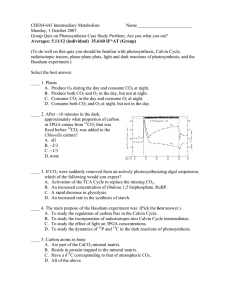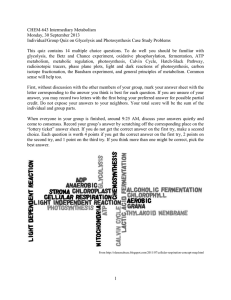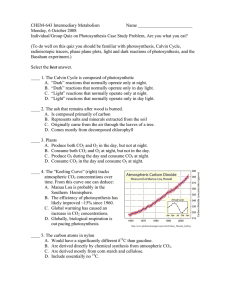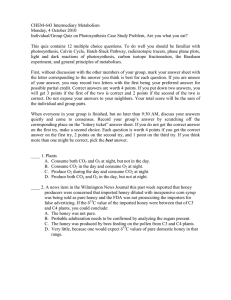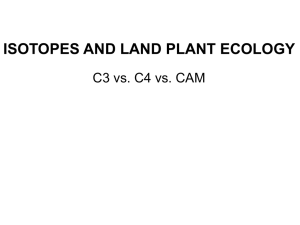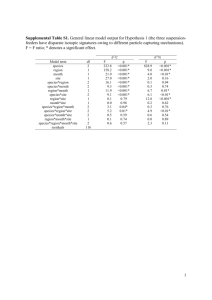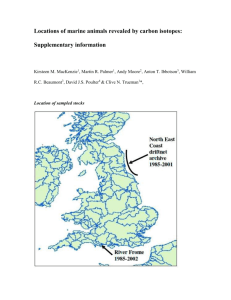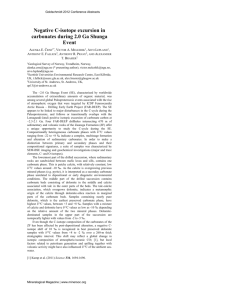CHEM-643 Intermediary Metabolism Monday, 3 October 2011
advertisement
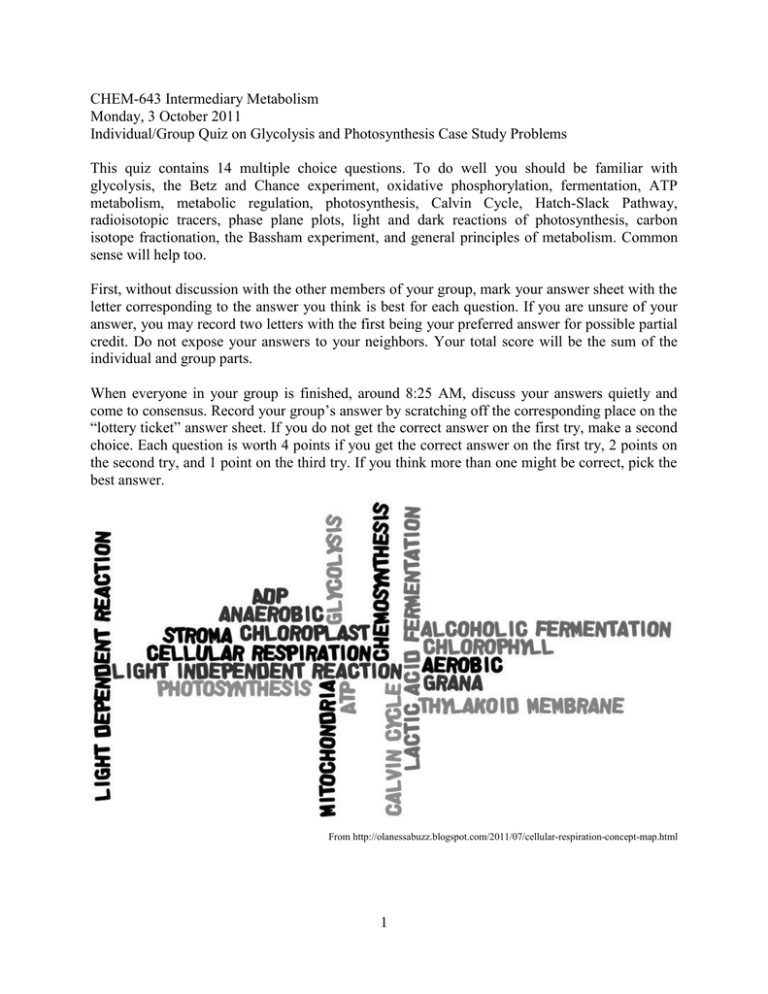
CHEM-643 Intermediary Metabolism Monday, 3 October 2011 Individual/Group Quiz on Glycolysis and Photosynthesis Case Study Problems This quiz contains 14 multiple choice questions. To do well you should be familiar with glycolysis, the Betz and Chance experiment, oxidative phosphorylation, fermentation, ATP metabolism, metabolic regulation, photosynthesis, Calvin Cycle, Hatch-Slack Pathway, radioisotopic tracers, phase plane plots, light and dark reactions of photosynthesis, carbon isotope fractionation, the Bassham experiment, and general principles of metabolism. Common sense will help too. First, without discussion with the other members of your group, mark your answer sheet with the letter corresponding to the answer you think is best for each question. If you are unsure of your answer, you may record two letters with the first being your preferred answer for possible partial credit. Do not expose your answers to your neighbors. Your total score will be the sum of the individual and group parts. When everyone in your group is finished, around 8:25 AM, discuss your answers quietly and come to consensus. Record your group’s answer by scratching off the corresponding place on the “lottery ticket” answer sheet. If you do not get the correct answer on the first try, make a second choice. Each question is worth 4 points if you get the correct answer on the first try, 2 points on the second try, and 1 point on the third try. If you think more than one might be correct, pick the best answer. From http://olanessabuzz.blogspot.com/2011/07/cellular-respiration-concept-map.html 1 CHEM-643 Intermediary Metabolism Glycolysis-Photosynthesis Quiz 3 October 2010 ___ 1. When the substrate oscillations eventually stop after the abrupt +O2 to –O2 transition in a yeast suspension, the following is true: A. Phosphofructokinase is strongly inhibited by ATP. B. The rate of glucose utilization is half the rate of pyruvate formation. C. Glycolysis stops. D. Oxidative phosphorylation resumes. ___ 2. In the presence of O2, yeast: A. Generate ATP exclusively by oxidative phosphorylation B. Generate ATP by oxidative phosphorylation and substrate-level phosphorylation C. Chemically convert NADH into ATP D. Produce ethanol ___ 3. In the absence of O2, yeast: A. Generate ATP exclusively by oxidative phosphorylation B. Generate ATP by oxidative phosphorylation and substrate-level phosphorylation C. Chemically convert NADH into ATP D. Produce ethanol ___ 4. During glycolytic oscillations of yeast in an aerobic-anaerobic transition, what relationship is true throughout? A. [ATP] = ½[ADP] + [AMP] B. [ATP] + [ADP] + [AMP] = constant C. [ATP] – [ADP] = [AMP] D. ([ATP] + ½[ADP])/([ATP] + [ADP] + [AMP]) = 1 ___ 5. A phase-plane plot (below) relating the concentrations of glucose-6-phosphate (G6P) and fructose-6-phosphate (F6P) in yeast cells is close to a straight line with a positive slope. This is because: A. [G6P] = [F6P] B. For every G6P used, one F6P is formed. C. The hexose monophosphate isomerase reaction has a favorable -ΔG◦’. D. The high hexose monophosphate isomerase activity maintains the reaction near a steadystate equilibrium. CHEM-643 Intermediary Metabolism Glycolysis-Photosynthesis Quiz 3 October 2010 ___ 6. Consider two identical photosynthesizing leaves of a C4 plant (e.g. bean plant) placed in separate vessels containing air at atmospheric CO2 concentrations. Vessel 1 is sealed so new air cannot come in, while the Vessel 2 remains open to the air. Photosynthesis is allowed to continue until the CO2 in Vessel 1 is used up. What can you predict about the δ13C values for newly fixed carbon? A. δ13C atmospheric CO2 = δ13C Vessel 1 > δ13C Vessel 2 B. δ13C atmospheric CO2 < δ13C Vessel 1 < δ13C Vessel 2 C. δ13C atmospheric CO2 = δ13C Vessel 1 < δ13C Vessel 2 D. δ13C atmospheric CO2 > δ13C Vessel 1 > δ13C Vessel 2 ___ 7. Consider two identical photosynthesizing leaves of a C3 plant (e.g. corn) placed in separate vessels containing air at atmospheric CO2 concentrations. Vessel 1 is sealed so new air cannot come in, while the Vessel 2 remains open to the air. Photosynthesis is allowed to continue until the CO2 in Vessel 1 is used up. What can you predict about the δ13C values for newly fixed carbon? A. δ13C atmospheric CO2 = δ13C Vessel 1 > δ13C Vessel 2 B. δ13C atmospheric CO2 < δ13C Vessel 1 < δ13C Vessel 2 C. δ13C atmospheric CO2 = δ13C Vessel 1 < δ13C Vessel 2 D. δ13C atmospheric CO2 > δ13C Vessel 1 > δ13C Vessel 2 ___ 8. The “Keeling Curve” (right) tracks atmospheric CO2 concentrations over time. From this curve one can deduce: A. The concentration of CO2 in the atmosphere was near zero 300-400 years ago. B. Global warming has caused an increase in CO2 concentrations. C. Manua Loa is in the northern hemisphere. D. Globally, biological respiration is out pacing photosynthesis. http://www.globalwarmingart.com/wiki/Carbon_Dioxide_Gallery ___ 9. The figure at the right from the Bassham experiment tracks the 32P and 14C in 3-Phosphoglycerate (3PGA) in a Chlorella suspension as a function of time after a light to dark transition in the presence of 32Pi and 14CO2. After 16 minutes of darkness: A. The concentration of 3PGA is less than when the lights were on. B. The ratio 32P/14C in 3PGA would be similar to that in ATP C. 3PGA is being converted to glyceraldehyde-3-phsophate in the Calvin Cycle. D. 3PGA is derived primarily from 12C starch via glycolysis. CHEM-643 Intermediary Metabolism Glycolysis-Photosynthesis Quiz 3 October 2010 ___ 10. Plants A. Consume both CO2 and O2 at night, but not in the day. B. Consume CO2 in the day and consume O2 at night. C. Produce O2 during the day and consume CO2 at night. D. Produce both CO2 and O2 in the day, but not at night. ___ 11. The curve at the right displays the amount of 14CO2 remaining in the atmosphere as the result of atmospheric atomic bomb testing in the 1950s and 1960s. If you could measure the 14C content of proteins in your eye lens or lipids in your brain, they would have a higher 14C specific radioactivity than proteins or lipids from your liver. A reasonable explanation would be: A. 14C compounds are specifically deposited in the brain. B. The decay of 14C is catalyzed by an enzyme in liver. C. Molecules in the liver are synthesized and degraded relatively rapidly. D. Molecules in the liver are precursors to those in the brain. The following diagram should be used for the next two questions. CHO CHO CH2O P GAP 1 GAP CH2OH C O CH2O P B CH2O P C O HO C H H C OH H C OH CH2O P A 3 4 CH2OH C O HO C H H C OH H C OH CH2O P 2 CHO H C OH H C OH CH2O P Conversion of 5 molecules of glyceraldehyde-3-P (GAP) into 3 molecules of ribulose-5-P (Ru5P) in the "carbon scamble" portion of the Calvin Cycle. 5 HO H H H CH2OH C O HO C H H C OH CH2O P 9 E CH2OH C O H C OH H C OH CH2O P Ru5P CH2O P GAP GAP CH2OH C O CH2O P D C 5 GAP H C OH CH2O P CH2O P GAP CHO H C OH H C OH CH2O P 2 CHO CHO H C OH H C OH B 7 CH2O P C O C H C OH C OH C OH CH2O P 6 F CHO H C OH H C OH H C OH CH2O P HO H H H CH2OH C O C H C OH C OH C OH CH2O P G 8 H CH2OH C O HO C H H C OH CH2O P 9 E CH2OH C O H C OH H C OH CH2O P CH2OH C O H C OH H C OH CH2O P Ru5P Ru5P 3 Ru5P CHEM-643 Intermediary Metabolism Glycolysis-Photosynthesis Quiz 3 October 2010 ____ 12. NaBH4 irreversibly inhibits lysine-dependent aldolases. Which of the following reactions would be inhibited by this treatment? A. 1 & 5 B. 2 & 6 C. 3 & 7 D. 4 & 8 ____13. Consider Reaction 4 only [GAP + C → D + E]. If the middle carbon (#2) of GAP were labeled, where would the label be found in compound D or E? ___ 14. The half-life of 14C is about 5700 years. What percent of the 14C originally present in a 57,000 year old fossil would remain today? A. ~0.01% B. ~0.1% C. ~1% D. ~10%
